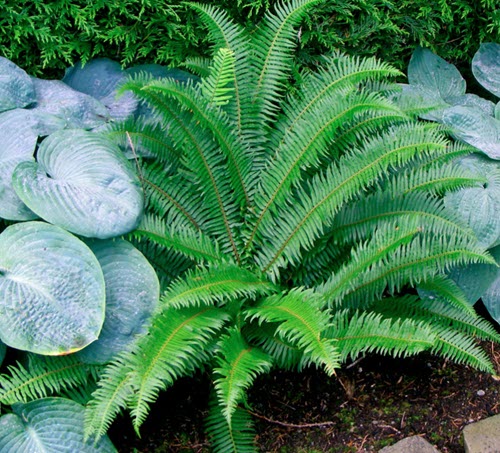Contents
This is a popular evergreen fern that can be purchased from standard garden centres and nurseries in many parts of the world. Several different varieties exist in the trade, including the popular Nephrolepis exaltata cv. Bostoniensis which sports arching wavy or curly fronds.

Sword ferns are commonly kept in standing pots or hanging baskets, and require plenty of space to develop the long fronds. They used to be very popular during the Victorian era and can, therefore, bring about a nostalgic classic feeling to a home. The sword fern is also known to be a powerful air purifier, and since it requires moist air to thrive, it can help remind us to keep the air humidity up in our homes – dry air is bad for both humans and sword ferns.
In sufficiently warm climates, Nephrolepis exaltata is a popular choice to control erosion and provide groundcover, and it is excellent for adding undergrowth below trees in a garden. It can spread out quickly through runners, so caution is required if this is not desired.
Description
This fern grows to be 50-250 cm tall and develops tufted clusters that grow from underground rhizomes. The pinnae (leaflets), which are shallowly toothed and display a vein pattern, can become up to 8 cm long.
The fronds grow upright at first, but will eventually arch downwards, forming an arching rosette.
Short info
Common names: Sword Fern, Fishbone Fern, Tuber Ladder Fern, Wild Boston Fern
Family: Lomariopsidaceae
Shape: Upright
Height: Up to 90 cm
Foliage: Green
Light: Bright but filtered
Temperature: 13°C to 24°C during the active growth period, 10°C to 13°C during the resting period
Humidity: High
Watering: Plentifully during the active growth period, moderately during the resting period
Native range and habitat
Nephrolepis exaltata is native to Central och South America, where it grows in jungle environments. It grows below larger trees and is therefore adapted to filtered light.
Keeping Sword fern as a houseplant
Light and position
Nephrolepis exaltata is adapted to life growing under tall trees in Central and South American forests and will, therefore, do best with bright but filtered light. Direct strong sunlight can damage it.
Potting medium
Nephrolepis exaltata likes humus-rich soil that drains well. Insufficient draining can easily cause root rot.
Temperature and humidity
The recommended temperature ranges are 13°C to 24°C during the active growth period and 10°C to 13°C during the resting period.
If the temperature is above 21°C, provide extra air humidity. It is difficult for this fern to endure temperatures in the higher range if the air is dry.
This is not considered a frost-tolerant species, but there are plenty of reports of individual plants surviving frosts and re-emerging in spring. Exposure to frost makes them look dead.
Watering
 Water in the morning, to give the fronds a lot of time to dry before night.
Water in the morning, to give the fronds a lot of time to dry before night.
During the active growth period, the fern needs lots of water and should be watered often.
As long as the air temperature is above 13°C the potting-medium should be kept moist at all times.
When the air temperature is 13°C or below, wait for the top-third of the potting-medium to dry out before you water again.
Humidity
This fern likes high humidity.
Nutrients
If the potting-medium is soil-based, it is usually sufficient to feed the fern with standard liquid fertilizer once a month. If the potting-medium is peat-based, increase to twice a month.
When grown in a garden, it is a good idea to add 5-10 cm of compost or peat moss to the ground in spring. Then, no additional fertiliser is required.
The Sword Fern is sensitive to salt, which should be taken into consideration.
Repotting
It is time to repot when the roots have filled the pot. The best time of the year to repot is spring.
